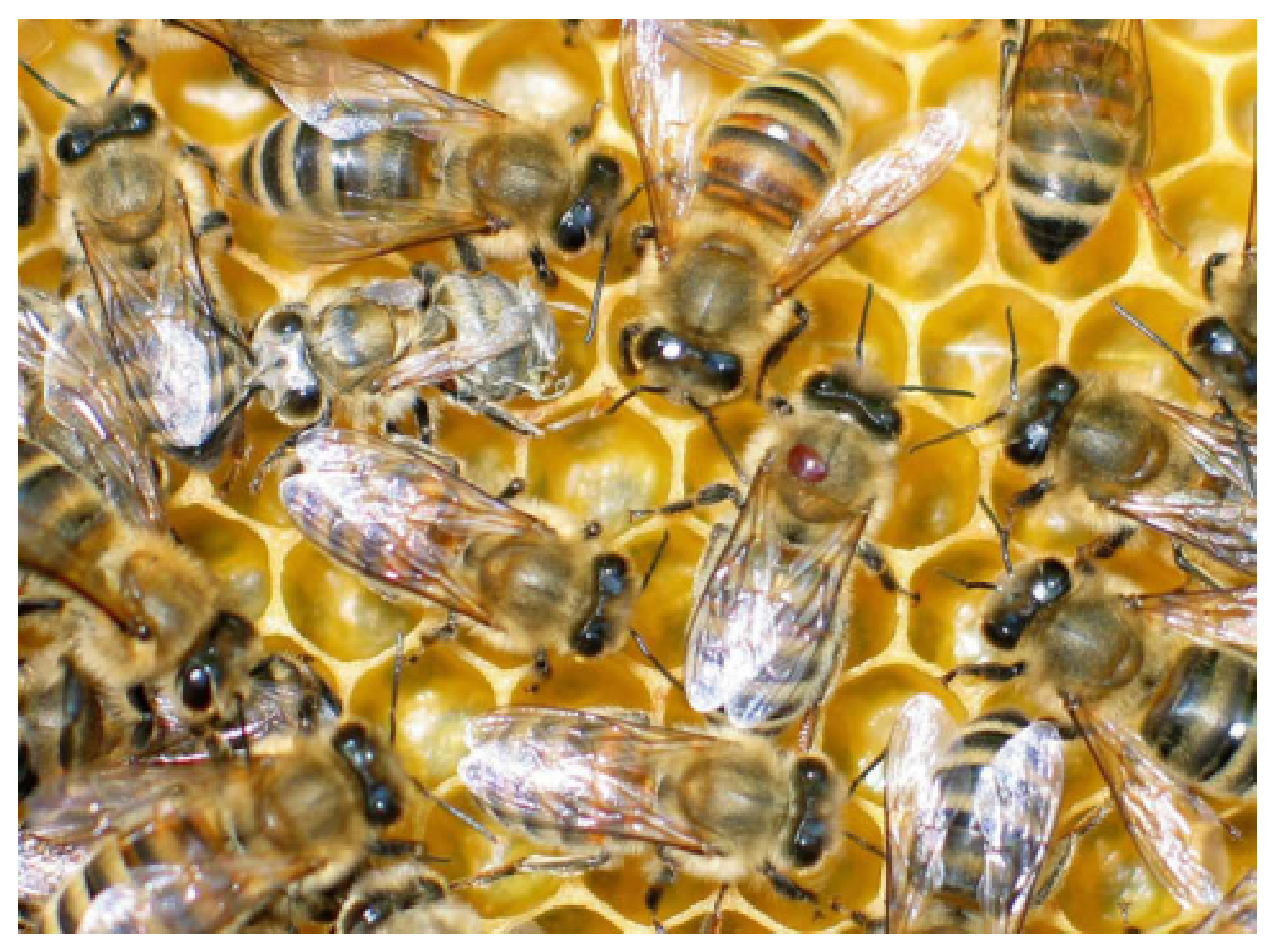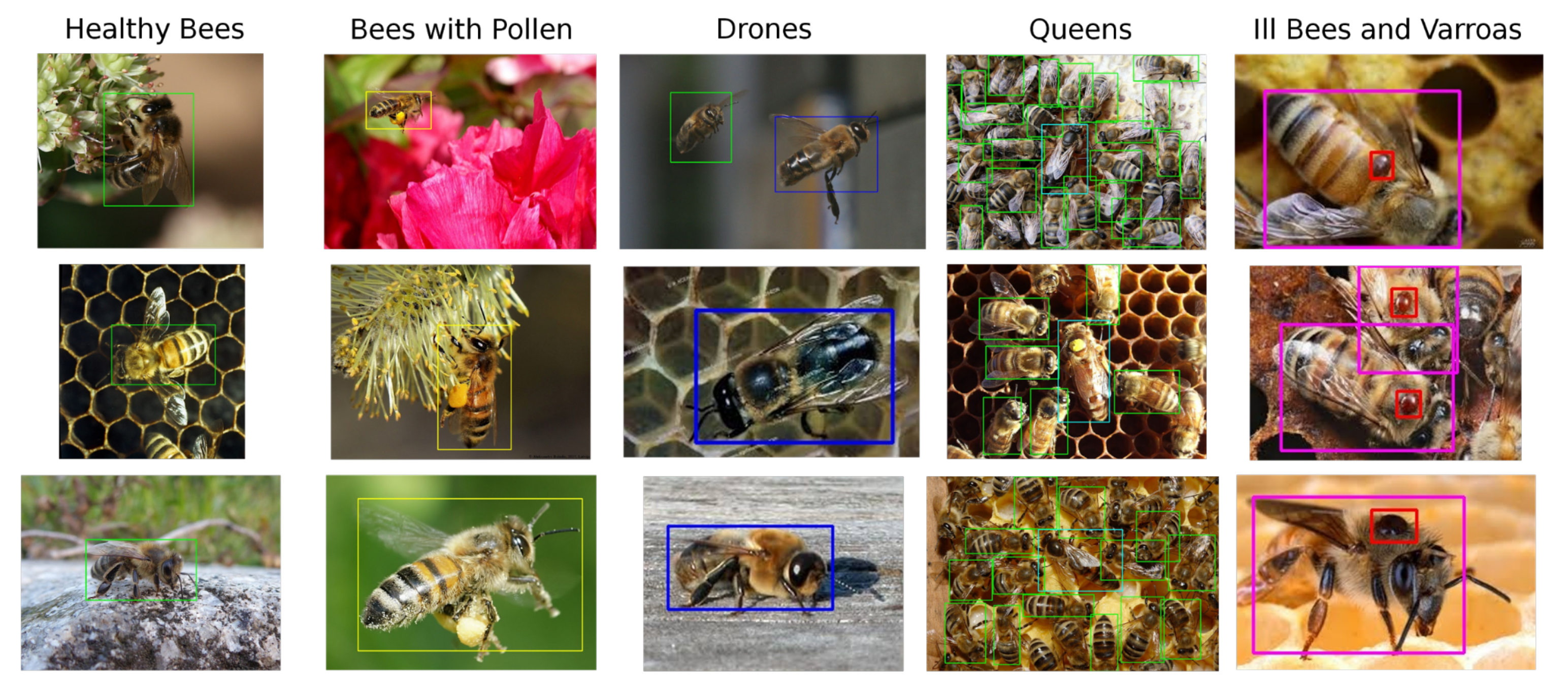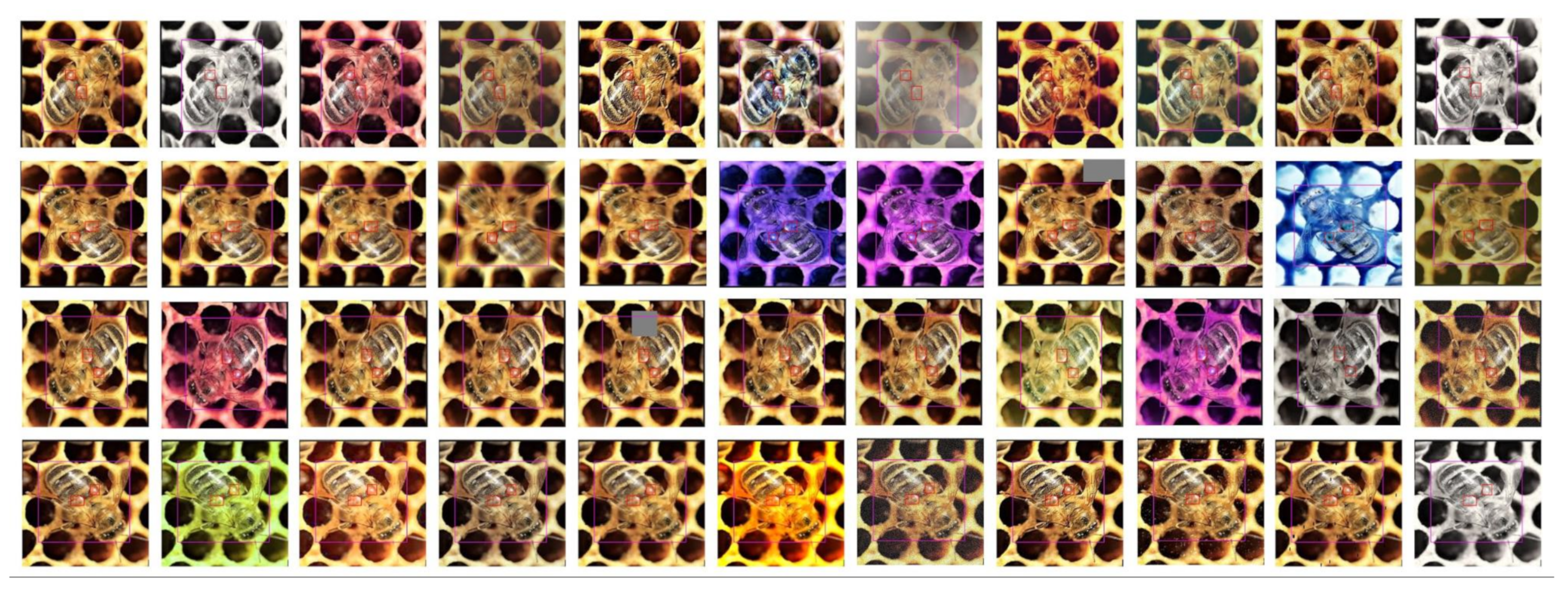Visual Diagnosis of the Varroa Destructor Parasitic Mite in Honeybees Using Object Detector Techniques
Abstract
:1. Introduction
2. Related Work
3. Materials and Methods
3.1. Dataset Description
3.2. Network Description
3.2.1. YOLOv5
3.2.2. SSD
3.2.3. Deep SVDD
3.3. Hyperparameters
3.4. Used Metrics
4. Results
4.1. YOLOv5
4.2. SSD
4.3. Deep SVDD
5. Discussion
6. Conclusions
Author Contributions
Funding
Institutional Review Board Statement
Informed Consent Statement
Data Availability Statement
Conflicts of Interest
References
- Rosenkranz, P.; Aumeier, P.; Ziegelmann, B. Biology and control of Varroa destructor. J. Invertebr. Pathol. 2010, 103, S96–S119. [Google Scholar] [CrossRef]
- Ramsey, S.D.; Ochoa, R.; Bauchan, G.; Gulbronson, C.; Mowery, J.D.; Cohen, A.; Lim, D.; Joklik, J.; Cicero, J.M.; Ellis, J.D.; et al. Varroa destructor feeds primarily on honey bee fat body tissue and not hemolymph. Proc. Natl. Acad. Sci. USA 2019, 116, 1792–1801. [Google Scholar] [CrossRef] [Green Version]
- Genersch, E.; Von Der Ohe, W.; Kaatz, H.; Schroeder, A.; Otten, C.; Büchler, R.; Berg, S.; Ritter, W.; Mühlen, W.; Gisder, S.; et al. The German bee monitoring project: A long term study to understand periodically high winter losses of honey bee colonies. Apidologie 2010, 41, 332–352. [Google Scholar] [CrossRef] [Green Version]
- Liebig, G. How many varroa mites can be tolerated by a honey bee colony. Apidologie 2001, 32, 482–484. [Google Scholar]
- Ferrari, S.; Silva, M.; Guarino, M.; Berckmans, D. Monitoring of swarming sounds in bee hives for early detection of the swarming period. Comput. Electron. Agric. 2008, 64, 72–77. [Google Scholar] [CrossRef]
- Mezquida, D.A.; Martínez, J.L. Platform for bee-hives monitoring based on sound analysis. A perpetual warehouse for swarm s daily activity. Span. J. Agric. Res. 2009, 4, 824–828. [Google Scholar] [CrossRef]
- De Souza, P.; Marendy, P.; Barbosa, K.; Budi, S.; Hirsch, P.; Nikolic, N.; Gunthorpe, T.; Pessin, G.; Davie, A. Low-cost electronic tagging system for bee monitoring. Sensors 2018, 18, 2124. [Google Scholar] [CrossRef] [PubMed] [Green Version]
- Bilík, Š. Honey bee (apis mellifera) colony monitoring methods with a potential application of the machine intelligence methods. In Proceedings of the 26th Conference STUDENT EEICT 2020; Brno University of Technology, FEEC: Brno, Czech Republic, 2020; pp. 351–355. [Google Scholar]
- Giuffre, C.; Lubkin, S.R.; Tarpy, D.R. Automated assay and differential model of western honey bee (Apis mellifera) autogrooming using digital image processing. Comput. Electron. Agric. 2017, 135, 338–344. [Google Scholar] [CrossRef] [Green Version]
- Knauer, U.; Zautke, F.; Bienefeld, K.; Meffert, B. A comparison of classifiers for prescreening of honeybee brood cells. In Proceedings of the International Conference on Computer Vision Systems: Proceedings (2007), Rio de Janeiro, Brazil, 14–21 October 2007. [Google Scholar]
- Rodriguez, I.F.; Megret, R.; Acuna, E.; Agosto-Rivera, J.L.; Giray, T. Recognition of pollen-bearing bees from video using convolutional neural network. In Proceedings of the 2018 IEEE Winter Conference on Applications of Computer Vision (WACV), Lake Tahoe, NV, USA, 12–15 March 2018; pp. 314–322. [Google Scholar]
- Rodriguez, I.F.; Megret, R.; Acuna, E.; Agosto-Rivera, J.L.; Giray, T. PollenDataset. 2017. Available online: https://github.com/piperod/PollenDataset (accessed on 29 November 2020).
- Yang, C.R. The Use of Video to Detect and Measure Pollen on Bees Entering a Hive. Ph.D. Thesis, Auckland University of Technology, Auckland, New Zealand, 2018. [Google Scholar]
- Ratnayake, M.N.; Dyer, A.G.; Dorin, A. Tracking individual honeybees among wildflower clusters with computer vision-facilitated pollinator monitoring. PLoS ONE 2021, 16, e0239504. [Google Scholar] [CrossRef] [PubMed]
- Kulyukin, V.; Mukherjee, S. On video analysis of omnidirectional bee traffic: Counting bee motions with motion detection and image classification. Appl. Sci. 2019, 9, 3743. [Google Scholar] [CrossRef] [Green Version]
- Rumpf, J. BWH Detector. 2019. Available online: https://github.com/JoeRu/bwh-detector (accessed on 24 March 2021).
- Szczurek, A.; Maciejewska, M.; Bak, B.; Wilk, J.; Wilde, J.; Siuda, M. Detection of Honeybee Disease: Varrosis using a Semiconductor Gas Sensor Array. In Proceedings of the SENSORNETS, 8th International Conference on Sensors Networks 2019, Prague, Czech Republic, 26–27 February 2017; pp. 58–66. [Google Scholar]
- Bauer, D.; Wegener, J.; Bienefeld, K. Recognition of mite-infested brood by honeybee (Apis mellifera) workers may involve thermal sensing. J. Therm. Biol. 2018, 74, 311–316. [Google Scholar] [CrossRef] [PubMed]
- Elizondo, V.; Briceño, J.C.; Travieso, C.M.; Alonso, J.B. Video Monitoring of a mite in honeybee cells. Adv. Mater. Res. 2013, 664, 1107–1113. [Google Scholar] [CrossRef]
- Schurischuster, S.; Zambanini, S.; Kampel, M.; Lamp, B. Sensor study for monitoring varroa mites on honey bees (apis mellifera). In Proceedings of the 23rd International Conference on Pattern Recognition 2016, Visual Observation and Analysis of Vertebrate and Insect Behavior Workshop, Cancun, Mexico, 4–8 December 2016. [Google Scholar]
- Schurischuster, S.; Remeseiro, B.; Radeva, P.; Kampel, M. A Preliminary Study of Image Analysis for Parasite Detection on Honey Bees. In International Conference Image Analysis and Recognition; Springer: Berlin/Heidelberg, Germany, 2018; pp. 465–473. [Google Scholar]
- Schurischuster, S.; Kampel, M. Image-based Classification of Honeybees. In Proceedings of the 2020 Tenth International Conference on Image Processing Theory, Tools and Applications (IPTA), Paris, France, 9–12 November 2020; pp. 1–6. [Google Scholar]
- Schurischuster, S.; Kampel, M. VarroaDataset (Version 1.2.0) [Data set]. Zenodo. 2020. Available online: http://doi.org/10.5281/zenodo.4085044 (accessed on 26 November 2020).
- Bjerge, K.; Frigaard, C.E.; Mikkelsen, P.H.; Nielsen, T.H.; Misbih, M.; Kryger, P. A computer vision system to monitor the infestation level of Varroa destructor in a honeybee colony. Comput. Electron. Agric. 2019, 164, 104898. [Google Scholar] [CrossRef]
- Chazette, L.; Becker, M.; Szczerbicka, H. Basic algorithms for bee hive monitoring and laser-based mite control. In Proceedings of the 2016 IEEE Symposium Series on Computational Intelligence (SSCI), Athens, Greece, 6–9 December 2016; pp. 1–8. [Google Scholar] [CrossRef]
- Yang, J. The BeeImage Dataset: Annotated Honey Bee Images. 2018. Available online: https://www.kaggle.com/jenny18/honey-bee-annotated-images (accessed on 29 November 2020).
- Lin, T. labelImg. 2015. Available online: https://github.com/tzutalin/labelImg (accessed on 8 December 2020).
- Shorten, C.; Khoshgoftaar, T.M. A survey on image data augmentation for deep learning. J. Big Data 2019, 6, 1–48. [Google Scholar] [CrossRef]
- Jung, A.B. Imgaug. 2021. Available online: https://github.com/aleju/imgaug (accessed on 1 January 2021).
- Zoph, B.; Cubuk, E.D.; Ghiasi, G.; Lin, T.Y.; Shlens, J.; Le, Q.V. Learning data augmentation strategies for object detection. In European Conference on Computer Vision; Springer: Berlin/Heidelberg, Germany, 2020; pp. 566–583. [Google Scholar]
- Redmon, J.; Divvala, S.; Girshick, R.; Farhadi, A. You only look once: Unified, real-time object detection. In Proceedings of the IEEE Conference on Computer Vision and Pattern Recognition, Las Vegas, NV, USA, 27–30 June 2016; pp. 779–788. [Google Scholar]
- Ren, S.; He, K.; Girshick, R.; Sun, J. Faster R-CNN: Towards real-time object detection with region proposal networks. IEEE Trans. Pattern Anal. Mach. Intell. 2016, 39, 1137–1149. [Google Scholar] [CrossRef] [PubMed] [Green Version]
- Jocher, G. Yolov5. In Code Repository; 2020; Available online: https://github.com/ultralytics/yolov5 (accessed on 8 November 2020).
- Paszke, A.; Gross, S.; Massa, F.; Lerer, A.; Bradbury, J.; Chanan, G.; Killeen, T.; Lin, Z.; Gimelshein, N.; Antiga, L.; et al. PyTorch: An Imperative Style, High-Performance Deep Learning Library. In Advances in Neural Information Processing Systems 32; Wallach, H., Larochelle, H., Beygelzimer, A., d’Alch’e-Buc, F., Fox, E., Garnett, R., Eds.; Curran Associates Inc.: Red Hook, NY, USA, 2019; pp. 8024–8035. [Google Scholar]
- Liu, W.; Anguelov, D.; Erhan, D.; Szegedy, C.; Reed, S.; Fu, C.Y.; Berg, A.C. Ssd: Single shot multibox detector. In European Conference on Computer Vision; Springer: Berlin/Heidelberg, Germany, 2016; pp. 21–37. [Google Scholar]
- Gao, H. Pytorch-Ssd. 2018. Available online: https://github.com/qfgaohao/pytorch-ssd (accessed on 14 December 2020).
- Ruff, L.; Vandermeulen, R.; Goernitz, N.; Deecke, L.; Siddiqui, S.A.; Binder, A.; Müller, E.; Kloft, M. Deep One-Class Classification. In Proceedings of the Machine Learning Research, Proceedings of the 35th International Conference on Machine Learning, Stockholm, Sweden, 10–15 July 2018; Dy, J., Krause, A., Eds.; PMLR: Stockholm, Sweden, 2018; Volume 80, pp. 4393–4402. [Google Scholar]
- Ruff, L. PyTorch Implementation of Deep SVDD. 2019. Available online: https://github.com/lukasruff/Deep-SVDD-PyTorch (accessed on 21 August 2020).
- Everingham, M.; Van Gool, L.; Williams, C.K.; Winn, J.; Zisserman, A. The pascal visual object classes (voc) challenge. Int. J. Comput. Vis. 2010, 88, 303–338. [Google Scholar] [CrossRef] [Green Version]
- Lin, T.Y.; Maire, M.; Belongie, S.; Hays, J.; Perona, P.; Ramanan, D.; Dollár, P.; Zitnick, C.L. Microsoft coco: Common objects in context. In European Conference on Computer Vision; Springer: Berlin/Heidelberg, Germany, 2014; pp. 740–755. [Google Scholar]
- Kratochvíla, L. Computing platforms for deep learning task in computer vision. In Proceedings of the 26th Conference STUDENT EEICT 2020; Brno University of Technology, FEEC: Brno, Czech Republic, 2020; pp. 171–175. [Google Scholar]






| All Classes Dataset | No. of Annotated Objects per Class | Images | |||||
| Bee Worker (No Pollen) | Bee Worker (Pollen) | Bee Drone | Bee Queen | Bee with V.mite(s) | V.-Mite | ||
| 1158 | 143 | 19 | 52 | 298 | 424 | 803 | |
| Bees and V.-mites Dataset | Classes | Bees | V.-Mite | Images |
| Train Set | 1148 | 250 | 561 | |
| Train Aug Set | 50,512 | 11,000 | 24,684 | |
| Val Set | 274 | 92 | 127 | |
| Test Set | 248 | 59 | 115 |
| Healthy and Ill Bees Dataset | Classes | Healthy Bees | Infected Bees | Images |
| Train Set | 956 | 192 | 561 | |
| Train Aug Set | 42,064 | 8448 | 24,684 | |
| Val Set | 220 | 54 | 127 | |
| Test Set | 196 | 52 | 115 |
| V.-Mites Dataset- | Classes Train Set | V.-Mite 250 | Images 561 |
| Train Aug Set | 11,000 | 24,684 | |
| Val Set | 92 | 127 | |
| Test Set | 59 | 115 |
| Base Net | Feature Map Size | Shringkage | Anchor Box | Aspect Ratio |
|---|---|---|---|---|
| VGG 16 | 80 | 8 | (15, 30) | [2, 3] |
| 40 | 16 | (30, 60) | [2, 3] | |
| 20 | 32 | (60, 105) | [2, 3] | |
| 10 | 64 | (105, 150) | [2, 3] | |
| 8 | 80 | (150, 200) | [2, 3] | |
| 6 | 107 | (250, 340) | [2, 3] | |
| MobileNet v2 | 40 | 16 | (15, 30) | [2, 3] |
| 20 | 32 | (30, 60) | [2, 3] | |
| 10 | 64 | (60, 105) | [2, 3] | |
| 5 | 128 | (105, 150) | [2, 3] | |
| 3 | 214 | (150, 200) | [2, 3] | |
| 2 | 320 | (200, 340) | [2, 3] |
| Bees and Varroa Mites Annotated Dataset | ||||||||||
|---|---|---|---|---|---|---|---|---|---|---|
| Metrics | mAP[0.5] | mAP[0.5:0.95] | F1 | Precision | Recall | |||||
| Yolov5 model | S | X | S | X | S | X | S | X | S | X |
| Bees | 0.953 | 0.946 | 0.610 | 0.647 | 0.827 | 0.859 | 0.711 | 0.762 | 0.989 | 0.985 |
| V.-Mites | 0.649 | 0.726 | 0.260 | 0.276 | 0.638 | 0.650 | 0.657 | 0.609 | 0.620 | 0.696 |
| Average | 0.801 | 0.845 | 0.435 | 0.462 | 0.733 | 0.754 | 0.684 | 0.686 | 0.805 | 0.841 |
| Healthy and Ill Bees Annotated Dataset | ||||||||||
| Metrics | mAP[0.5] | mAP[0.5:0.95] | F1 | Precision | Recall | |||||
| Yolov5 model | S | X | S | X | S | X | S | X | S | X |
| Healthy Bees | 0.932 | 0.938 | 0.589 | 0.676 | 0.826 | 0.865 | 0.722 | 0.824 | 0.964 | 0.910 |
| Ill Bees | 0.902 | 0.908 | 0.726 | 0.746 | 0.838 | 0.874 | 0.825 | 0.902 | 0.852 | 0.848 |
| Average | 0.917 | 0.923 | 0.658 | 0.711 | 0.832 | 0.870 | 0.774 | 0.863 | 0.908 | 0.879 |
| Varroa Mites Annotated Dataset | ||||||||||
| Metrics | mAP[0.5] | mAP[0.5:0.95] | F1 | Precision | Recall | |||||
| Yolov5 model | S | X | S | X | S | X | S | X | S | X |
| V.-Mites | 0.777 | 0.752 | 0.328 | 0.327 | 0.656 | 0.666 | 0.585 | 0.626 | 0.746 | 0.712 |
| Bees and Varroa Mites Annotated Dataset | ||||||||||
|---|---|---|---|---|---|---|---|---|---|---|
| Metrics | mAP[0.5] | mAP[0.5:0.95] | F1 | Precision | Recall | |||||
| Base Net | VGG | MB2 | VGG | MB2 | VGG | MB2 | VGG | MB2 | VGG | MB2 |
| Bees | 0.354 | 0.547 | 0.234 | 0.281 | 0.529 | 0.556 | 0.920 | 0.512 | 0.371 | 0.609 |
| V.-Mites | - | 0.529 | - | 0.252 | - | 0.681 | - | 0.914 | - | 0.542 |
| Average | - | 0.533 | - | 0.266 | - | 0.619 | - | 0.713 | - | 0.576 |
| Healthy and Ill Bees Annotated Dataset | ||||||||||
| Metrics | mAP[0.5] | mAP[0.5:0.95] | F1 | Precision | Recall | |||||
| Base Net | VGG | MB2 | VGG | MB2 | VGG | MB2 | VGG | MB2 | VGG | MB2 |
| Healthy Bees | - | 0.395 | - | 0.203 | - | 0.520 | - | 0.541 | - | 0.5 |
| Ill Bees | - | 0.182 | - | 0.114 | - | 0.318 | - | 0.909 | - | 0.192 |
| Average | - | 0.288 | - | 0.159 | - | 0.419 | - | 0.725 | - | 0.346 |
| Varroa Mites Annotated Dataset | ||||||||||
| Metrics | mAP[0.5] | mAP[0.5:0.95] | F1 | Precision | Recall | |||||
| Base Net | VGG | MB2 | VGG | MB2 | VGG | MB2 | VGG | MB2 | VGG | MB2 |
| V.-Mites | 0.355 | 0.519 | 0.184 | 0.239 | 0.242 | 0.714 | 0.980 | 0.897 | 0.322 | 0.593 |
| Detecting V.-Mite Presence | ||||||||
|---|---|---|---|---|---|---|---|---|
| mAP[0.5] | F1 Score | |||||||
| Training Dataset | YOLOv5 S | YOLOv5 X | SSD-VGG | SSD-MobNv2 | YOLOv5 S | YOLOv5 X | SSD-VGG | SSD-MobNv2 |
| Bees and V.Mites (V.-mite score only) | 0.649 | 0.726 | - | 0.529 | 0.638 | 0.650 | - | 0.681 |
| Health and Ill Bees (ill bees score only) | 0.902 | 0.908 | - | 0.182 | 0.838 | 0.874 | - | 0.318 |
| V.-Mites Only | 0.777 | 0.752 | 0.355 | 0.519 | 0.656 | 0.666 | 0.242 | 0.714 |
| Neural Netoworks Inference Duration [ms] | ||||
|---|---|---|---|---|
| GPUs | YOLOv5 | SSD | ||
| S | X | VGG | MobNetv2 | |
| 1080 Ti | 0.045 | 0.011 | 0.665 | 0.109 |
| 2080 Ti | 0.031 | 0.012 | 0.932 | 0.106 |
Publisher’s Note: MDPI stays neutral with regard to jurisdictional claims in published maps and institutional affiliations. |
© 2021 by the authors. Licensee MDPI, Basel, Switzerland. This article is an open access article distributed under the terms and conditions of the Creative Commons Attribution (CC BY) license (https://creativecommons.org/licenses/by/4.0/).
Share and Cite
Bilik, S.; Kratochvila, L.; Ligocki, A.; Bostik, O.; Zemcik, T.; Hybl, M.; Horak, K.; Zalud, L. Visual Diagnosis of the Varroa Destructor Parasitic Mite in Honeybees Using Object Detector Techniques. Sensors 2021, 21, 2764. https://doi.org/10.3390/s21082764
Bilik S, Kratochvila L, Ligocki A, Bostik O, Zemcik T, Hybl M, Horak K, Zalud L. Visual Diagnosis of the Varroa Destructor Parasitic Mite in Honeybees Using Object Detector Techniques. Sensors. 2021; 21(8):2764. https://doi.org/10.3390/s21082764
Chicago/Turabian StyleBilik, Simon, Lukas Kratochvila, Adam Ligocki, Ondrej Bostik, Tomas Zemcik, Matous Hybl, Karel Horak, and Ludek Zalud. 2021. "Visual Diagnosis of the Varroa Destructor Parasitic Mite in Honeybees Using Object Detector Techniques" Sensors 21, no. 8: 2764. https://doi.org/10.3390/s21082764
APA StyleBilik, S., Kratochvila, L., Ligocki, A., Bostik, O., Zemcik, T., Hybl, M., Horak, K., & Zalud, L. (2021). Visual Diagnosis of the Varroa Destructor Parasitic Mite in Honeybees Using Object Detector Techniques. Sensors, 21(8), 2764. https://doi.org/10.3390/s21082764







